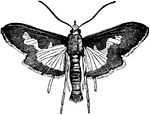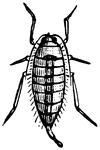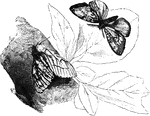
Caterpillar of the Luna Moth
"Among the larger and more splendid moths of our own country is the Luna Moth, or Green Emperor Moth,…

Chrysalis of the Luna Moth
"Among the larger and more splendid moths of our own country is the Luna Moth, or Green Emperor Moth,…
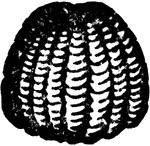
Owl Moth
The owl moth is a moth whose larvae are known to feed on a wide array of plants including a range of…

Pickle Moth Larva
The larva of a Margaronia nitidalis on a small cucumber which had been eaten into.

Pine Beauty Moth
Pine beauty moth is the common name of trachea piniperda. This moth is a heavy bodied insect with variegated…
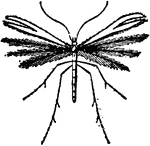
Plume Moth
"The insects of the group Pterophorina, are remarkable from the peculiar conformation of their wings.…

Plume Moth
"The insects of the group Pterophorina, are remarkable from the peculiar conformation of their wings.…

Satellite Sphinx Moth
"Philampelus satellitia, a large and handsome hawk-moth whose larva feeds upon the vine. Natural size.…

Sphinx Moth
"The Sphingina or Sphinx Moths, so callled from the curious havit which the larva have of raising the…

Sphinx Moth
"The Sphingina or Sphinx Moths, so callled from the curious havit which the larva have of raising the…
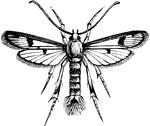
Sugar-Maple Moth
An illustration of a sugar-maple moth. A moth is an insect closely related to the butterfly, both being…
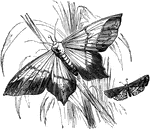
Swallow-Tailed Moth
The swallow-tailed moth (Ourapteryx sambucaria) and the many-plumed moth (Ourapteryx hexadactyla).
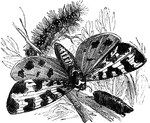
Tiger Moth
The garden tiger moth (Arctia caja) is named for the different and colorful patterns on its wings.

Garden Tiger Moth
The Garden Tiger Moth (Arctia caja) is a species of tiger moths that are also known by the synonym Euprepia…

Tortricidae
Tortricidae is a family of moths in the order Lepidoptera. They are commonly known as tortrix moths.…

Wingless Moth (Female)
An illustration of a wingless female moth. Most species of moth are nocturnal, but there are crepuscular…
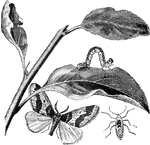
Male, Female, and Larva of the Mottled Umber Moth
Mottled umber moth is the common name of hybernia defoliaria. The moths emerge between October and March.…

Noctuina
"The Noctuina form an eceedingly large group of nocturnal moths, although even here there are a few…

Noctuina
"The Noctuina form an eceedingly large group of nocturnal moths, although even here there are a few…

Potherb Moth
The hind wings of the potherb moth are frequently unspotted. The body is thick and heavy. The color…
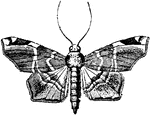
Pyralidina
"The Pyralidina are a group of small moths readily distinguished by their long slender bodies and large…
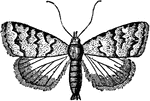
Pyralidina
"The Pyralidina are a group of small moths readily distinguished by their long slender bodies and large…
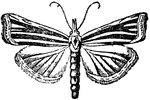
Pyralidina
"The Pyralidina are a group of small moths readily distinguished by their long slender bodies and large…

Pyralidina
"The Pyralidina are a group of small moths readily distinguished by their long slender bodies and large…
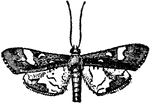
Pyralidina
"The Pyralidina are a group of small moths readily distinguished by their long slender bodies and large…
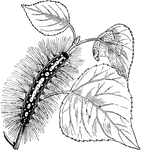
Caterpillar of the Satin Moth
Satin moth is the common name of liparis salicis. The caterpillar bears a row of white spots down the…
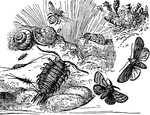
Types of Seashore Life
16. Andrena cineraria, 17. Helix virgata, 18. Pod-lover moth, 19. Anurida maritima, 20. Machillis maritima,…
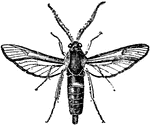
Sesiidae
"Clear-winged moths, Sesiidae, day-fliers, and looking more like bees, wasps, and ichneumons which they…
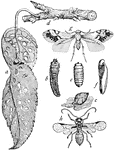
Resplendent Shield Bearer
"Resplendent Shield-bearer (Coptodisca splendoriferella). a, leaf of apple showing work; b, summer larva;…

Silkworm Moth, Caterpillar, and Chrysalis
"This important insect is a native of the north of China; and a great portion of the supplies of silk…

Skipper
"The Hesperidae or Skippers, so called from their jerky hesitating mode of flight, show, in the thickness…

Skipper
"The Hesperidae or Skippers, so called from their jerky hesitating mode of flight, show, in the thickness…
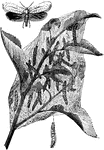
Small Ermine Moth and Web of Caterpillars
The front wings are the small ermine moth are white or gray with numerous small black dots. The lower…
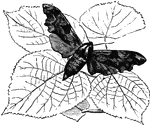
Lime-tree sphinx
"The Lime-tree sphinx, Sphinx tiliae, has the wings denticulated and angular; it is nocturnal,…

White-Lined Morning Sphinx
Deilephila lineata"...a common American moth of striking coloration, whose larva feeds on purslane."…

White-Lined Morning Sphinx
Deilephila lineata"...a common American moth of striking coloration, whose larva feeds on purslane."…

Tineina
"The Tineina contain the smallest of the Lepidoptera, and are best known as clothes moths. These clothe…

Tineina
"The Tineina contain the smallest of the Lepidoptera, and are best known as clothes moths. These clothe…
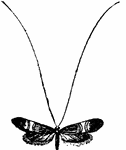
Tineina
"The Tineina contain the smallest of the Lepidoptera, and are best known as clothes moths. These clothe…

Tomato Worm
The Five-Spotted Hawkmoth (Manduca quinquemaculata) is a brown and gray hawk moth of the Sphingidae…

Tortricina
"The Tortricina include a great number of small moths exceedingly injurious to orchard and other trees.…

Vapourer Moth
Vapourer moth is the common name of orgyia antiqua. Pictured is the male moth. The body is dark brown…
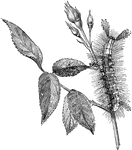
Larva of Vapourer Moth
Vapourer moth is the common name of orgyia antiqua. The larva is covered with yellowish hairs. The larva…

Warblers Eating Caterpillars
An illustration of warblers feeding on the young caterpillars of the Gipsy moth.
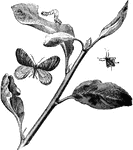
Male, Female, and Caterpillar of the Winter Moth
Female winter moths have wings so small that they have little to no use. The females must crawl up the…


